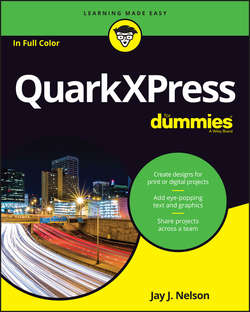Читать книгу QuarkXPress For Dummies - Nelson Jay J. - Страница 5
На сайте Литреса книга снята с продажи.
Part 1
Getting Started with QuarkXPress
Chapter 1
Meeting QuarkXPress 2016
Understanding What QuarkXPress Does
ОглавлениеQuarkXPress is a page layout program. To build a page, you draw a few boxes (containers) and fill them with content (text, pictures, and other stuff). Add a few rules (lines) and frames (picture edges) and you have a layout. If you’re clever, you link your page to a master page (which holds items such as page numbers and headers that repeat on multiple pages) and organize your page items on layers (to cluster related items together for viewing or printing).
Everything on a QuarkXPress page is referred to as an item.
Over the years, QuarkXPress has evolved to support the needs of publishers and designers with major new capabilities such as interactive and animated items, Bézier (pen) tools that rival Adobe Illustrator, real-time collaboration with others working on the same document, creating e-books and even mobile apps, supplying powerful table-creation tools, converting content from other programs into native QuarkXPress items, creating anchored callouts, and providing support for dozens of languages in the same document.
In case the built-in features aren’t enough for you, you can buy and add third-party XTensions to QuarkXPress, which are plug-ins that add new capabilities ranging from one feature to an entire automated database publishing system.
Quark is the company’s name. QuarkXPress is the product’s name. Quark has other products besides QuarkXPress. Just as you would never say “Adobe” when referring to Photoshop or Acrobat, or “Microsoft” when referring to Word or Excel, you don’t refer to QuarkXPress as “Quark.” That said, you commonly hear people say “Quark” when referring to QuarkXPress. Use your social judgment to decide which name you want to use.
Quark was founded by a science geek who named the company after the elementary particle that is a fundamental constituent of matter. In keeping with that science nerdiness, one XTension (QuarkXPress plug-in) developer cleverly named his company Gluon, which is the elementary particle that “glues” quarks together to form protons and neutrons.
HOW QUARK REVOLUTIONIZED PUBLISHING
Quark was founded in 1981 in Denver, Colorado, by Tim Gill. After writing several successful programs for the Apple II and Apple III computers (including Word Juggler and Catalyst), Gill saw Apple’s Macintosh computer and realized that it could change the world of publishing. Until that time, publishing systems were available to only the wealthiest members of society, at a cost of several hundred thousand dollars. But in the late 1980s, all publishing required was a Macintosh, QuarkXPress, and a LaserWriter – at a total cost of less than $10,000.
This tenfold reduction in the price of publishing indeed created a new worldwide industry that came to be known as Desktop Publishing. But most important, it put publishing into the hands of those formerly without a voice. This was the idea that most excited Gill, who in 1986 took on a financial partner named Fred Ebrahimi. Together, they conquered the publishing world in several ways: by building QuarkXPress into the tool that 90 percent of publishers wanted to use; by extending its reach into historically disenfranchised areas of the world such as India, Latin America, and portions of East Asia; and by supporting a cottage industry of trainers and XTension developers.
Being a programmer himself, Gill had a special place in his heart for independent programmers who wanted to make a difference in the world but wanted to work for themselves. He held training events for XTension developers, invited them to Quark’s events, and even helped set up a worldwide marketing distributor for XTensions so that the developers could spend their time coding instead of marketing. Quark benefitted, of course, by being able to focus on improving the core set of features in QuarkXPress needed by most users, and allowing the XTension developers to provide solutions for specific needs. When some of those XTensions later became features in QuarkXPress, Gill always tried to take care of the developers. (When Quark released a Windows version of QuarkXPress, Gill cleverly released free XTensions to give features to Mac users that weren’t possible to create in Windows.)
In 2000, Gill sold his half of Quark to Fred Ebrahimi to focus on philanthropic endeavors such as The Gill Foundation. Quark and QuarkXPress never fully recovered from Gill’s departure, but still maintain a strong presence in enterprise and vertical markets that value efficiency. (In 2006, Fred Ebrahimi gave all his shares of Quark Inc. to his children, with his daughter Sasha taking the position of Chairman. In 2006, Quark also hired Raymond Schiavone, former CEO of Arbortext, as its new CEO. In 2011, the Ebrahimi family sold all its shares to Platinum Equity, a California-based private equity firm that focuses on underperforming companies with high potential.)
